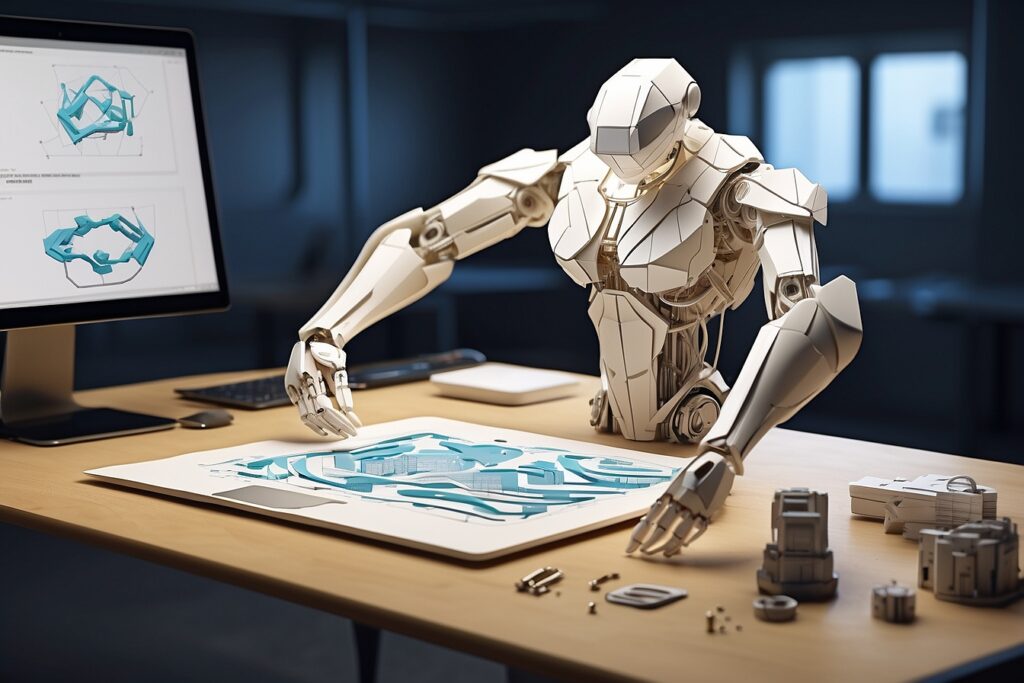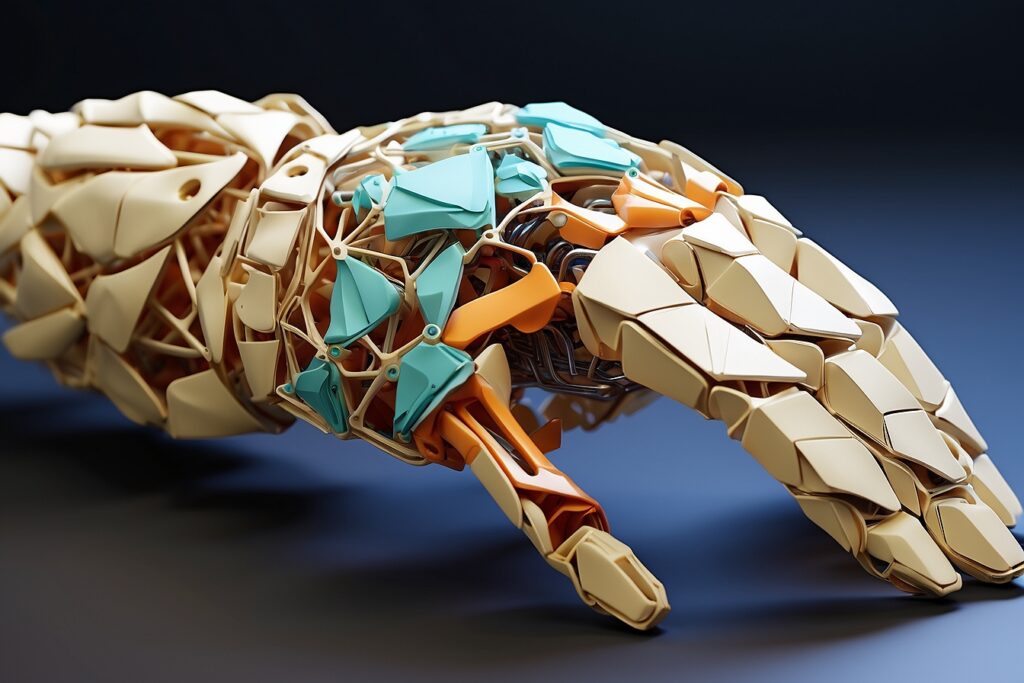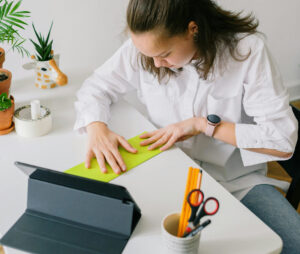Key Takeaways
- AI enables rapid exploration of complex origami designs beyond human capability.
- Machine learning can optimize origami structures for specific engineering applications.
- AI automation streamlines the origami design process from concept to production.
- AI has the potential to uncover novel folding principles by synthesizing vast amounts of origami research.
A sheet of paper transforming into a complex, functional structure: That’s origami for you – an art that’s been around for centuries. But hold on to your paper cranes, folks, because origami is getting a high-tech makeover!
In recent years, origami has morphed from a cool hobby into a problem-solving powerhouse. Scientists and engineers are now using origami principles to tackle challenges in aerospace, architecture, robotics, and even medicine. It’s like origami decided to get a Ph.D. and start solving real-world problems!
But here’s the kicker – as origami patterns get more complex, even the brightest minds struggle to keep up. Enter AI, stage left, ready to give origami design a serious boost.
Table of Contents
Why AI in Origami? Because We Can!
AI brings some serious muscle to the origami party:
- It can explore design possibilities faster than you can say “paper airplane”
- It optimizes origami structures for specific functions (think: origami-inspired satellite arrays)
- It automates the design process, saving time and reducing headaches
- It uncovers new folding techniques hidden in piles of research papers
Sounds pretty neat, right?

AI: The Origami Brainiac
Imagine trying to fold a paper into a million different shapes. Sounds exhausting? Well, that’s where AI steps in, as a tireless origami enthusiast with infinite patience.
Algorithmic Design: Folding at the Speed of Light
AI uses fancy techniques like genetic algorithms and neural networks to explore countless folding patterns. It’s a smart tool which can analyse a billion origami designs in the blink of an eye.
Particularly, genetic algorithms work by simulating evolution. They start with a bunch of random designs, pick the best ones, mix them up, and repeat. Over time, they “evolve” better and better origami patterns.
Optimization: Making Origami Work Smarter, Not Harder
AI doesn’t just create random folds. It’s like a master chef, tweaking the recipe until it’s just right. Using machine learning, AI can optimize origami designs for specific purposes:
- Want a solar panel that unfolds in space? AI’s got you covered.
- Need a robot that can squeeze through tight spaces? AI will fold you one.
- Dreaming of a self-assembling shelter? AI’s already sketching it out.
By simulating how designs behave in the real world, AI can fine-tune every crease and fold. It can show you how your origami will perform before you even touch the paper.
AI: The Origami Factory
Automation: From Concept to Creation
AI doesn’t just design – it streamlines the whole process:
- You tell AI what you want (e.g., “a compact, foldable chair”)
- AI generates designs and simulates how they’d work
- The best designs get refined and optimized
- Voila! You’ve got blueprints ready for production
This automation isn’t just cool – it’s revolutionary. It means we can create complex origami structures faster and cheaper than ever before. Imagine printing out a flat sheet that folds itself into a functional object. That’s the kind of future AI is folding for us.
Customization: Origami, Your Way
Want an origami design that’s uniquely yours? AI can tailor designs to specific needs or preferences. Imagine:
- A foldable laptop stand that fits your exact device
- Custom packaging that’s both beautiful and functional
- Medical devices shaped to fit individual patients
AI makes personalized origami a reality, not just a pipe dream. Imagine a master origami artist on call, ready to create exactly what you need.

AI: The Origami Naturalist
Nature’s been doing origami for millions of years. Just look at how a leaf unfurls or an insect’s wings fold. AI is taking notes and getting inspired.
Biomimicry: Folding Like Mother Nature
AI can simulate natural processes to create origami designs that mimic the elegance of the natural world.
For example, AI might study how leaves unfold from buds to create energy-efficient solar panels. Or it could mimic the way insects fold their wings to design compact drones. By learning from nature’s time-tested designs, AI can help us create origami structures that are both beautiful and functional.
AI: The Origami Artist
Now, here’s where things get really interesting. Can AI be creative? Can it make origami that’s not just functional, but beautiful?
The Art of AI Origami
Teaching AI to appreciate the aesthetics of origami is tricky. Can you explain why a sunset is beautiful to a calculator? But we’re making progress:
- AI can analyze thousands of origami designs to learn what humans find appealing
- It can generate new designs that combine elements in unexpected ways
- Some AI models can even mimic different artistic styles
Imagine an AI that can create origami in the style of your favorite artist, or blend different cultural folding traditions into something entirely new.
But origami artists don’t need to worry, origami artists – AI isn’t here to replace them. Think of it as a super-powered sketchbook, full of wild ideas waiting to be refined by human hands.

AI: The Origami Scholar
Imagine having a friend who’s read every book on origami ever written. That’s what AI can do for origami research.
Knowledge Synthesis: Connecting the Dots
AI can dig through mountains of research papers, finding connections humans might miss.
- It can spot trends across different fields of origami research
- It might uncover forgotten folding techniques ripe for modern applications
- It could even suggest new research directions by identifying gaps in current knowledge
This AI-powered research could lead to breakthroughs we can’t even imagine yet. Maybe we’ll discover a folding pattern that revolutionizes packaging, or a technique that makes buildings more earthquake-resistant. The possibilities are as endless as the folds in a sheet of paper.
The Wrinkles in the Paper
Before we get too carried away, let’s talk about some challenges:
- The Black Box Problem: Sometimes, AI’s design choices are hard to understand.
- Computer Power Hunger: Simulating complex folds takes serious computing muscle. We’re talking more processing power than it takes to run your favorite video game.
- Data Dilemmas: AI needs lots of good data to learn from. Finding enough high-quality origami designs to train on can be tough.
- The Beauty Question: Teaching AI to understand the artistry of origami is like teaching a fish to appreciate a bicycle. We’re making progress, but it’s not easy.
- Keeping the Human Touch: We don’t want to lose the magic of human creativity in origami. Finding the right balance between AI assistance and human artistry is key.

Folding Our Way to the Future
So, what’s next for AI in origami? The possibilities are as limitless as the folds in a sheet of paper:
- Self-folding buildings that adapt to their environment
- Origami-inspired medical devices that can be inserted into the body and then unfold to perform procedures
- Space structures that compact for launch and expand in orbit
But here’s the real magic: AI and origami together can help us solve problems we haven’t even thought of yet. It’s not just about making cool paper sculptures (though that’s awesome too). It’s about using the principles of folding to tackle big challenges in engineering, medicine, and beyond.
To make this future a reality, we need teamwork:
- Mathematicians to crack the code of complex folding patterns
- Engineers to dream up new applications for origami structures
- Artists to keep the soul of origami alive
- AI researchers to push the boundaries of what’s possible
Together, humans and AI can unfold a future that’s more fascinating than anything we could imagine alone.
So next time you fold a paper airplane or crane, remember: you’re not just playing with paper. You’re touching the edge of a revolution that’s reshaping our world, one crease at a time.
Now, who’s ready to start folding the future?




